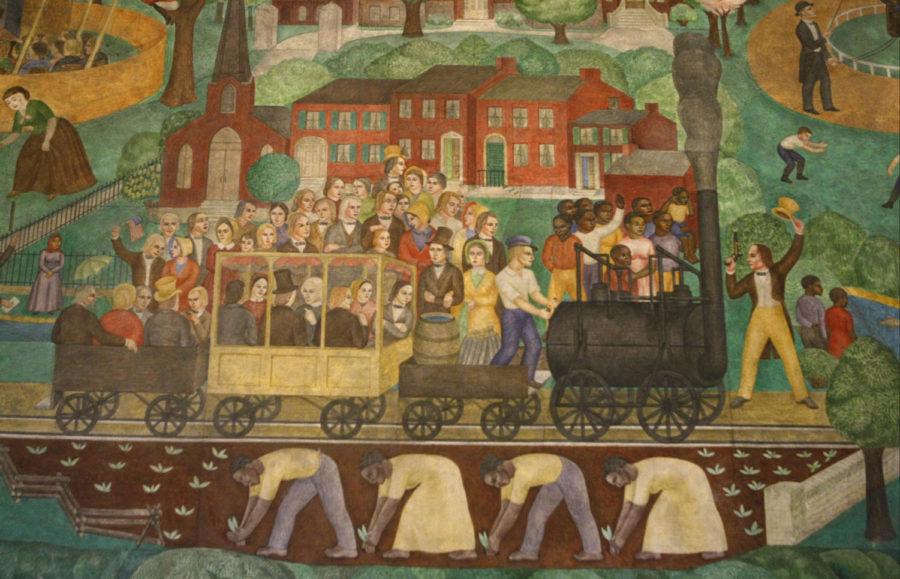Documentary on controversial mural shown in Memorial Hall
February 13, 2020
In the lobby of Memorial Hall, a white sheet covered Ann Rice O’Hanlon’s controversial fresco.
In the auditorium of Memorial Hall, images of the fresco panned across a screen, accompanied by audio from student protests. The images were part of “Painted in Stone: The Kentucky Mural,” a documentary that was shown at UK on Wednesday.
The documentary traces the history of race relations at UK and, specifically, the fresco in Memorial Hall.
John Fitch III, a professor of broadcasting and electronic media at EKU, made the documentary over the summer of 2019.
The film debuted in September on EKU’s campus. It was brought to UK as part of the Year of Equity.
Dr. Julia Bursten, a professor of philosophy at UK, organized the showing. She first saw the film in the library downtown and wanted to bring it back to UK so it could be encountered in the space it’s about.
“I wanted to create an additional context for the film itself so that we could engage with the complicated questions about race that are symbolized and capsulated in this mural,” said Bursten.
Created in 1934 as part of the Works Progress Administration, the mural was intended to show a history of central Kentucky – now, it is a lightning rod for racial tensions at UK. Its depiction of black Americans has led some students to call it “the slave mural.”
Students petitioned for the removal of the mural in 2006, 2015 and 2019. In 2018, additional artwork by Karyn Olivier was commissioned to add context to the mural. Her work covers the ceiling of Memorial Hall’s atrium.
The documentary juxtaposes the mural’s history with questions about censorship, art interpretation and individual responsibility.
Two UK faculty and a UK student, Tsage Douglas, were featured in the film. Douglas was president of the Black Student Union during the occupation of UK’s Main Building in April of 2019.
Administrative officials declined to be interviewed for the documentary.
The conclusion of the documentary focused on the future of the mural. Many of those interviewed in the film said they did not think it should be destroyed, but that it should be removed from Memorial Hall in some way because the prominence of its location.
After the documentary showing, makers and interviewees of the film answered questions from the crowd.
Fitch, Jim Embry, Chris Huestis and Dr. Emily Elizabeth Goodman served on the panel.
The audience asked questions about the making of the film, especially how Fitch selected sources and interviewees.
Fitch said his process making the documentary focused on the people involved, such as student protestors and people who had written articles about it.
“I definitely didn’t approach this as a way to bash the university,” said Fitch, a UK alum. He said he became interested in the controversy after a heated conversation with a colleague.
“By the time I got back to my office, I said ‘I have to do something on this’,” said Fitch.
Production on the documentary began a little over a month after the occupation in 2019, he said, and was completed in eight weeks over the summer.
“We wanted to get it as soon as possible,” said Fitch during the Q&A.
During the panel, Dr. Goodman, an art historian at Transylvania University, said that the fresco could potentially be preserved through digital reproduction or other methods.
“Yes, you’d be losing the original material, but you’d be still doing exactly what the conservation process is,” said Goodman, who added that the original is in good condition for reclamation.
The documentary also suggested that the mural could be removed through conservation and digital reproduction.
The administration has previously expressed reluctance to remove or destroy the mural. Because frescoes are painted onto plaster while still wet, they are difficult to remove without harming the work or the structure.
“We’re a culture, oftentimes, of destroying art,” said Embry, who added that UK has been tearing down buildings and neighborhoods throughout its history. Embry was a founding member of the Black Student Union in 1968 and served as the organization’s president.
Currently, the mural remains covered by a sheet. The university has stopped scheduling mandatory classes in Memorial Hall.






























































































































































